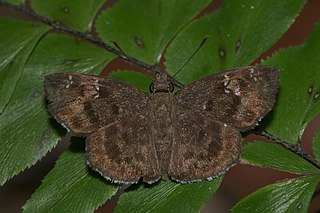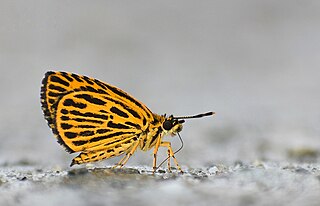
Aeromachus dubius, the dingy scrub-hopper, is a butterfly belonging to the family Hesperiidae. It ranges from India to China, including Malaya, Assam, Myanmar, Laos, Vietnam, Hainan and Yunnan.

Iambrix salsala, the chestnut bob, is a butterfly belonging to the family Hesperiidae, that is found in parts of South Asia and Southeast Asia.

Quedara basiflava, the yellow-base flitter or golden flitter, is a butterfly belonging to the family Hesperiidae and is endemic to India's Western Ghats.

Sarangesa dasahara, also known as the common small flat, is a species of butterfly in the family Hesperiidae. It is found in the Indomalayan realm.

Hyarotis adrastus, the tree flitter, is a butterfly belonging to the family Hesperiidae found in South Asia and Southeast Asia.

Bindahara phocides, the plane, is a small butterfly found Indomalayan and Australasian realms that belongs to the lycaenids or blues family.

Jamides celeno, the common cerulean, is a small butterfly found in Indomalayan realm belonging to the lycaenids or blues family. The species was first described by Pieter Cramer in 1775.

Anthene emolus, the ciliate blue, is a small butterfly found in India and southeast Asia that belongs to the lycaenids or blues family. The species was first described by Jean-Baptiste Godart in 1823.

Celaenorrhinus is a genus of skipper butterflies which are commonly termed sprites. An alternate name is flats, for their habit of holding their wings flat when resting, but this is also used for related genera. They are the type genus of tribe Celaenorrhinini.

Ancema blanka, the silver royal, is a species of lycaenid or blue butterfly found in the Indomalayan realm. The species was first described by Lionel de Nicéville in 1894.

Tajuria melastigma, the branded royal, is a species of lycaenid or blue butterfly found in the Indomalayan realm.

Deudorix perse, the large guava blue, is a species of lycaenid or blue butterfly found in the Indomalayan realm. It was described by William Chapman Hewitson in 1863. The larva feeds on Randia dumetorum.

Rapala lankana, the Malabar flash, is a species of lycaenid or blue butterfly found in South India and Sri Lanka. It was first described by Frederic Moore in 1879.

Hasora anura, the slate awl, is a species of hesperid butterfly found in Asia. In India it is found in Sikkim and the Khasi Hills.

Gangara lebadea, commonly known as the banded redeye, is a species of hesperid butterfly found in Southeast Asia.

Thoressa honorei, commonly known as the Madras ace, is a skipper butterfly belonging to the family Hesperiidae found in south India.

Parnara bada, the African straight swift, grey swift or Ceylon swift, is a butterfly of the family Hesperiidae. It is found in south-east Asia, from India through China to Indonesia, as well as the north-east coast of Australia.

Papilio diophantus is a species of swallowtail butterfly from the genus Papilio that is found in Sumatra.

Catopyrops ancyra, or Felder's lineblue, is a species of butterfly belonging to the lycaenid family described by Cajetan Felder in 1860. It is found in the Indomalayan and Australasian realms.

Ochus subvittatus, the tiger hopper, is the only species in the monotypic moth genus Ochus of the family Hesperiidae. The genus was erected by Lionel de Nicéville in 1894. The species was first described by Frederic Moore in 1878. It is found in the Khasi Hills and Naga Hills of India, Myanmar, Thailand, Laos, Vietnam and Yunnan.



















